Physical Address
304 North Cardinal St.
Dorchester Center, MA 02124
Visual acuity (VA), which is a measure of the patient’s ability to resolve fine detail, is the most commonly used measurement of visual function. Distance and reading VAs are used to assess the adequacy of glasses or contact lenses and as a key indicator of ocular health. Distance VA is also used to assess a person’s fitness to drive or enter into some professions, such as the police force, and to enable registration as a visually impaired or blind person. However, note that VA only describes a part of how reduced vision affects how a patient functions in day-to-day activities and reductions in contrast sensitivity ( section 3.3 ), visual field ( sections 3.6 to 3.10 ), colour vision ( sections 3.4 and 3.5 ), and stereopsis ( section 3.11 ) must also be considered.
There are three principal measures of VA:
Unaided VA, often called vision.
Habitual (‘presenting’ or ‘walk in’) VA, with the patient’s own glasses, if worn, or without glasses if not worn.
Optimal VA, with the best refractive correction (i.e., after subjective refraction, see section 4.5 ).
The term best-corrected visual acuity (BCVA), although widely used in ophthalmology texts, can refer to a wide range of VA types (VA with spectacles, pinhole, autorefractor result, after a subjective spherical over-refraction, etc.) and is best avoided.
Habitual VA should be measured immediately after the case history for legal reasons to document the VA level prior to your examination. Measuring unaided VA (vision) in patients who wear glasses is optional, and should be measured with patients who:
Have lost/broken their spectacles;
Do not wear spectacles for some distance viewing tasks (this information must therefore be obtained in the case history);
Require the information for a report;
Wear their spectacles all the time for distance and yet you suspect they may not need to (does the young low hyperope need to wear the spectacles for distance tasks?)
VA charts using the logMAR system are widely available on computer-based systems with flat panel displays and are much superior to Snellen charts. , These VA charts ( Fig. 3.1 ) use the design principles suggested by Bailey and Lovie, including 0.1 logMAR progression of letter size from −0.30 to 1.0 logMAR (VAR 115 to 50; Snellen equivalents of 6/3 to 6/60; 20/10 to 20/200 and 2.0 to 0.1 in decimal), five letters per line, letters of similar legibility, and per-letter scoring. , VA measurements using logMAR charts have been shown to be twice as repeatable as those from a Snellen chart and over three times more sensitive to inter-ocular differences in VA and therefore substantially more sensitive to amblyopic changes, for example. , VA measurements on computer-based systems have the advantage of allowing randomisation of letters, calculation of VA scores, and conversion of VA into different notations. The concern that patients may be worried if they are not able to see the smaller letters on a logMAR chart can be avoided by explaining that the new chart includes lines with smaller text than the old one and indicate, or even highlight, the 100 VAR line (Snellen 6/6, 20/20 or 1.0). Current computer-based VA charts are typically limited by screen sizes, so that lines of letters larger than about 70 VAR (6/24, 0.25, 20/80) have progressively fewer than five letters ( Fig. 3.2 ) and this needs to be considered in measurement and/or recording.

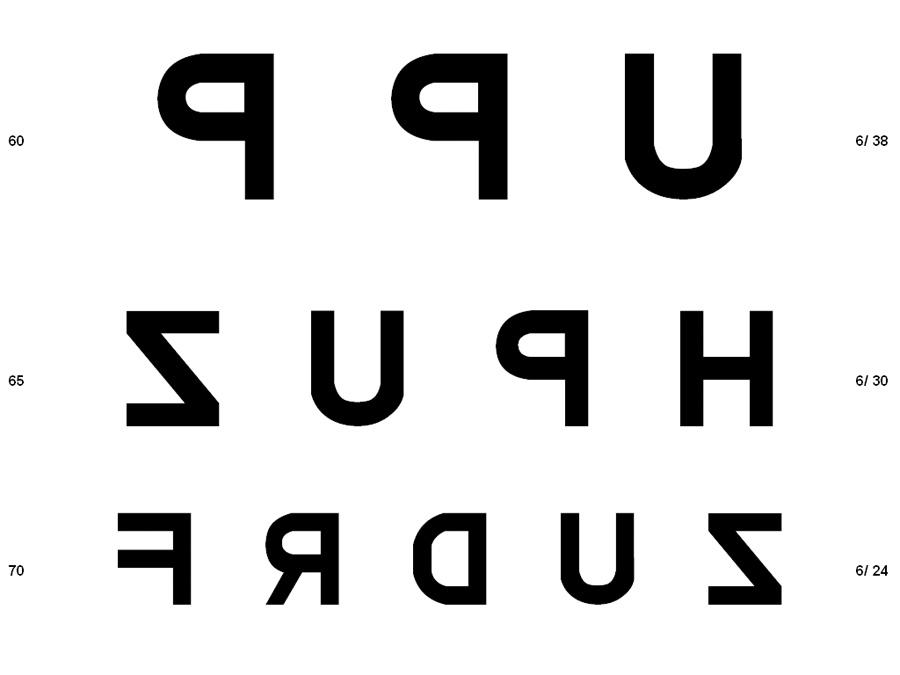
VA is typically assessed at 6 m or 20 feet and can be described in a large variety of formats, including metric (e.g., 6/6), imperial (20/20), and decimal Snellen (1.0), log of the minimum angle of resolution or logMAR (0.0), visual acuity rating or VAR (100) and number of letters read (85). , Number of letters read is confusing and very rarely matches the actual number of letters read. For example, ‘85 letters read’ (6/6, 20/20, 1.0) on a standard logMAR chart with five letters per line includes only 55 letters from 6/60 (20/200, 0.1) down to the 6/6, 20/20, 1.0 Snellen equivalent line. , It will not be discussed further. VAs in logMAR are non-intuitive as they get lower as VA improves and high values of VA are negative. In addition, errors can arise when subtracting 0.02 for each letter misread given that 6/9 −1 and 6/7.5 −1 are 0.18 and 0.08 but 6/6 -1 and 6/4.8 −1 are −0.02 and −0.12. Therefore, VAs will be described using VAR because it is simple, intuitive, and recommended with by-letter scoring on a logMAR-design chart and equivalent values in metric, imperial, and decimal Snellen will then be provided because these are widely used and understood throughout different parts of the world.
Snellen charts were devised by the German ophthalmologist Hermann Snellen in 1862 and have been widely used ever since. There is not a standard Snellen chart and the letter size sequences, number of letters and/or numbers and varieties of letters, vary from manufacturer to manufacturer. The majority have one 6/60 (20/200, 0.10) letter, two 6/36 (20/125, 0.17) letters, and three 6/24 (20/80, 0.25) letters. They typically do not contain lines of letters at 6/30 (20/100, 0.20) or 6/48 (20/160, 0.125), and many charts have a bottom line of 6/5 (∼20/15, 1.20) and thus provide truncated data given that the average VA of a young adult is about 107 VAR (6/4, 20/13, 1.50; Table 3.1 ) and many see better than this. Measuring VA with a Snellen chart and a bottom line of 6/6 (20/20, 1.0) or even 6/5 (∼20/15, 1.20) thus takes the approach of measuring ‘distance vision adequacy’ (i.e., determining whether distance VA is adequate for a patient’s daily needs, similar to the approach used for reading VA) rather than distance VA (a threshold measurement). A truncated chart makes the detection of slightly reduced VA caused by eye disease or uncorrected refractive error in patients with good VA impossible. For example, if your chart (or measurement technique) is truncated to 6/6 (20/20, 1.0), you will not be able to detect the more than one line of VA loss from the average VA of a 30-year-old of 107 VAR (6/4.5, 20/15, 1.40) to 100 VAR.
| Age (yr) | VAR | Snellen (metric) | Decimal Snellen | Snellen (imperial) | LogMAR |
| 20–49 | 107 (101 to 113) |
6/4.5 +1 (6/6 +1 to 6/3 −2 ) |
1.25 +2 (1.0 +1 to 2.0 −2 ) |
20/15 +1 (20/20 +1 to 20/10 −2 ) |
−0.14 (−0.02 to −0.26) |
| 50–59 | 105 (100 to 110) |
6/5 +1 (6/6 to 6/3.8) |
1.25 (1.0 to 1.6) |
20/15 −1 (20/20 to 20/13) |
−0.10 (0.00 to −0.20) |
| 60–69 | 103 (98 to 108) |
6/5 −1 (6/6 −2 to 6/4 −1 ) |
1.25 −2 (1.0−2 to 1.25 +3 ) |
20/15 −2 (20/20 −2 to 20/13 −1 ) |
−0.06 (0.04 to −0.16) |
| 70+ | ∼100 (96 to 106) |
6/6 (6/7.5 −1 to 6/4.5) |
1.0 (0.8 −1 to 1.25 +1 ) |
20/20 (20/25 −1 to 20/15) |
~0.00 (0.08 to −0.12) |
(See online ![]() .)
.)
Ensure the chart is at the appropriate distance and is calibrated correctly. The luminance of the chart should be between 80 and 320 cd/m 2 . Leave the room lights on.
Seat the patient comfortably with an unobstructed view of the test chart. You should sit in front and to one side of the patient in order to monitor facial expressions and reactions.
Take measurements in a systematic order: (1) vision (unaided VA) of the right eye, (2) vision of the left eye, (3) binocular vision, (4) habitual VA (with spectacles) of the right eye, (5) habitual VA of the left eye, (6) binocular habitual VA.
Explain what measurement you are about to take. This can be as simple as “Now we shall find out what you can see in the distance.”
Instruct the patient: “Please cover up your left/right eye with the palm of your hand/this occluder.” Some clinicians prefer to hold the occluder over the patient’s eye themselves to ensure it is properly occluded.
Ask the patient: “Please read the smallest line that you can see on the chart” or similar.
Continually monitor the patient to ensure they do not screw their eyes up or look around the occluder or through their fingers.
If the patient states they cannot see any smaller letters, push the patient to read more. Use prompts such as “Can you see any letters on the next line?” or “Have a guess. It doesn’t matter if you get any wrong.” Many patients will read further. Stop pushing patients to read more if they make four or more mistakes on a line of five letters.
Score VA using a by-letter system and the VAR system (see section 3.1.5 ) and/or an equivalent Snellen ( section 3.1.5 ).
If the patient cannot see the largest letters on the chart, ask them to move closer to the letter until two or three lines can be seen (or use a printed panel chart at a reduced distance). Note the distance at which this occurs. If the patient cannot see the letters even at the closest test distance, use the following test sequence. Stop at the level at which the patient can accurately respond.
Hand movements (HM) @ Y cm: The patient can see a hand moving from a certain distance. Some computerised VA tests can provide accurate measurements down to the hand movements level and these should be used when available.
Light projection (Lproj.): The patient can report from which direction the light is coming when you hold a penlight about 50 cm away. Ask the patient to point to the light and note the areas of the field in which the patient has light perception.
Light perception (LP): The patient can see the light but not from where it is coming. If they cannot see light, the vision is recorded as no light perception or NLP.
Record vision/VA.
Randomise the letters on computer-based systems and repeat measurements as necessary.
Check whether the VAs are similar in the two eyes, changed since their last examination, and/or below age-matched normal values (see section 3.1.6 ).
School age children are typically able to use adult-style logMAR charts. Preferential looking tests, such as the Teller acuity cards and the Cardiff acuity test, are used to measure VA in infants and toddlers. LogMAR-based charts with contour bars around the line of letters/pictures should be used when measuring VA in children and these include letter (crowded Keeler or HOTV) and picture (Kay, Lea, Patti Pic) logMAR charts ( Fig. 3.3 ). Amblyopia can be missed if single letters are used rather than a letter chart because of the lack of contour interaction, and logMAR crowded charts have been shown to be over three times more sensitive to inter-ocular differences in VA than single letter Snellen charts and therefore substantially more sensitive to amblyopic changes. Crowded logMAR charts can be used in children who do not know their letters by providing them with a key card that includes a selection of the letters from the chart. You then point to a letter on the chart and ask the child to identify the letter on their key card. Kay pictures have been shown to over-estimate VA compared with letter charts and it may be best to use other charts for patients who are likely to use adult VA charts in subsequent visits.
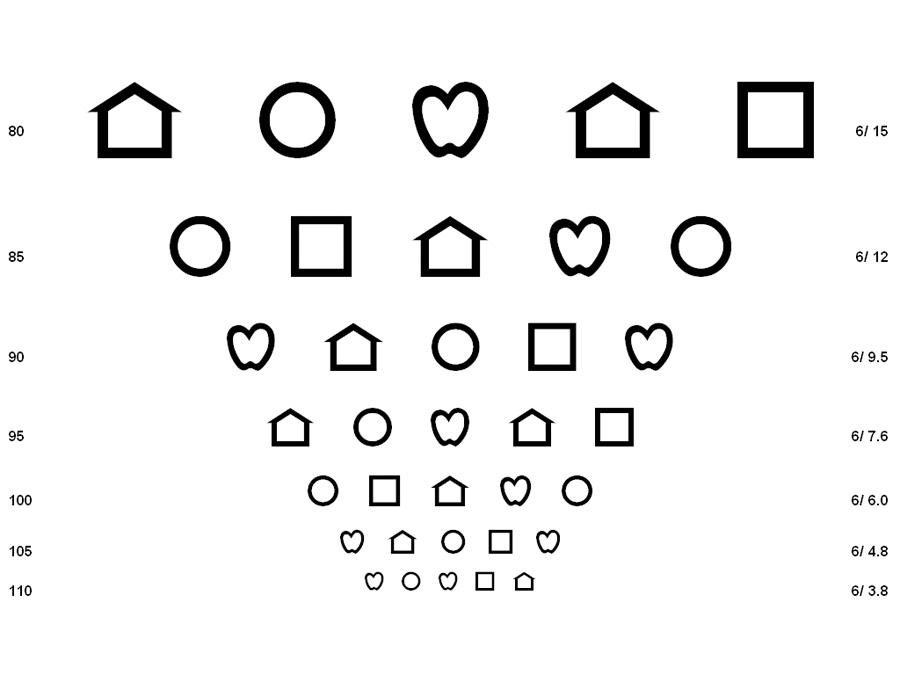
Disability glare can be simply assessed by remeasuring VA while directing a glare source, such as a penlight or ophthalmoscope, into the eye. Use a standard light source, distance and angle from the eye (e.g., from 30 cm and 30°) to ensure the glare light at the eye is repeatable. A poor VA in glare conditions can provide justification for early referral of patients with cataract or posterior capsular opacification who have good VA in normal light conditions. Typically, most patients will show no change in VA or loss of up to one line. Some patients with cataract, particularly those with posterior subcapsular cataract ( Fig. 3.4 , section 8.4.1 ), can lose four lines of VA and more.

VA measurements can be scored in logMAR notation, using the VAR score or converting scores to an equivalent Snellen value. VAR = 100 − 50 logMAR, but see Table 3.2 and Figs. 3.1 and 3.2 to see that it is much easier than using the formula as computerised logMAR VA charts can be set up to display the VAR score of each line. At lower levels of VA, many computer-based charts do not include five letters on a line (see Fig. 3.2 ) so that each letter is worth 5/N (VAR) and with rounding lines with four, three, and two letters per line are worth approximately 1, 2, and 2.5 VAR. VAR or equivalent Snellen can be used on your own record cards. Equivalent Snellen values should be provided when writing referral letters and reports, because currently Snellen notation is universally understood, whereas VAR is not. Comparisons of VA in VAR and Snellen (metric, imperial and decimal) plus logMAR and MAR are shown in Table 3.2 .
| VAR | Snellen (metric) | Snellen (imperial) | Decimal a | MAR a | LogMAR |
| 115 | 6/3 | 20/10 | 2.0 | 0.50 | −0.30 |
| 110 | 6/3.8 | 20/12.5 | 1.60 | 0.63 | −0.20 |
| 105 | 6/4.8 | 20/16 | 1.25 | 0.80 | −0.10 |
| 100 | 6/6 | 20/20 | 1.00 | 1.00 | 0.00 |
| 95 | 6/7.5 | 20/25 | 0.80 | 1.25 | 0.10 |
| 90 | 6/9.5 | 20/32 | 0.63 | 1.60 | 0.20 |
| 85 | 6/12 | 20/40 | 0.50 | 2.0 | 0.30 |
| 80 | 6/15 | 20/50 | 0.40 | 2.5 | 0.40 |
| 75 | 6/19 | 20/63 | 0.32 | 3.2 | 0.50 |
| 70 | 6/24 | 20/80 | 0.25 | 4.0 | 0.60 |
| 65 | 6/30 | 20/100 | 0.20 | 5.0 | 0.70 |
| 60 | 6/38 | 20/125 | 0.16 | 6.3 | 0.80 |
| 55 | 6/48 | 20/160 | 0.125 | 8.0 | 0.90 |
| 50 | 6/60 | 20/200 | 0.10 | 10.0 | 1.00 |
| 35 | 6/120 | 20/400 | 0.05 | 20 | 1.30 |
| 20 | 6/240 | 20/800 | 0.025 | 40 | 1.60 |
| 0 | 6/600 | 20/2000 | 0.01 | 100 | 2.00 |
Snellen VA is recorded as the smallest line in which the majority of the letters are seen and refined by appending plus or minus 1, 2, or 3 (e.g., 6/5 −1 , 20/20 +3 ). If the patient could not see the 6/60 letter at 6 m, but could at 2 m, record 2/60. Similarly if the patient could not see the 20/200 letter at 20 feet, but could see the 20/120 letter at 5 feet, record 5/120.
Vision or ‘VA ![]() Rx’ or VAsc or Vsc all mean visual acuity measured without a correction.
Rx’ or VAsc or Vsc all mean visual acuity measured without a correction.
VA ![]() Rx or VAcc mean visual acuity measured with a correction and generally refer to the VA with the patient’s glasses. PH refers to pinhole VA and PHNI indicates that the pinhole provided no improvement ( section 4.5.2 ). VA measured with the patient’s contact lenses would typically be recorded as VA
Rx or VAcc mean visual acuity measured with a correction and generally refer to the VA with the patient’s glasses. PH refers to pinhole VA and PHNI indicates that the pinhole provided no improvement ( section 4.5.2 ). VA measured with the patient’s contact lenses would typically be recorded as VA ![]() CLs or similar. VAs are recorded for the right eye (RE or OD), left eye (LE or OS), and binocular (BE or OU).
CLs or similar. VAs are recorded for the right eye (RE or OD), left eye (LE or OS), and binocular (BE or OU).
Examples
Without glasses and with the right eye, a patient reads all the letters down to the 100 VAR row but gets one letter wrong on this row and reads none of the next row correctly. Their VA should be calculated as 99 VAR (with equivalent Snellen values of 6/6 −1 , 20/20 −1 , and 1.0 −1 ) and recorded as Vision RE: 99 VAR (or Vsc OD: 99 VAR).
With their glasses and left eye a patient reads all of the letters on the 100 VAR row correctly and three letters on the line (105) below and one letter on the following (110) line. This is equivalent to four letters after the 100 line and should be calculated as 104 VAR (with equivalent Snellen values of 6/6 +4 , 20/20 +4 , or 1.0 +4 ) and recorded as VA LE: 104 VAR (or VAcc OS 104 VAR).
With their glasses and with both eyes, a patient cannot see any letters at 6 m and can only see the top three lines at 2 m. They read the 55 row correctly at 2 m and two letters on the line (60) below. This would be calculated as 57 VAR −25 VAR (for the reduction in test distance from 6 m to 2 m; see Table 3.3 ) = 32 VAR.
| Chart distance | VAR | Snellen (metric) | Snellen (imperial) | Decimal* | LogMAR |
| (using a 6m chart) | |||||
| 3 m | −15 | 3/x | 10/x | (Calculated | +0.30 |
| 2 m | −25 | 2/x | ∼7/x | from | +0.50 |
| 1.5 m | −30 | 1.5/x | 5/x | Snellen) | +0.60 |
| 1 m | −40 | 1/x | ∼3/x | +0.80 | |
| (using a 4 m chart) | |||||
| 2 m | −15 | 2/x | 2/x | +0.30 | |
| 1 m | −30 | 1/x | 1/x | +0.60 |
Any deviation from normal age-matched results, as shown in Table 3.1 , should be noted. The average VA for patients less than 50 years of age is about 107 VAR (∼6/4.5, 20/15, 1.3; a little more than a line better than 6/6, 20/20, or 1.0) so that 6/6, 20/20, and 1.0 represent reduced VA for the great majority of younger patients. 6/6, 20/20, and 1.0 Snellen only become the average VA for patients of about 70 years of age with healthy eyes. You must also check whether there has been any change in VA from the previous examination. In patients with normal or near normal VA, a significant change in VA is more than 5 VAR or one line. , Also note any inter-ocular asymmetry of a line (5 VAR) or more, or a binocular result that is worse than the monocular response. If VA improves with a pinhole, it suggests that either the subjective refraction could be improved (and therefore should be repeated) or there is some other optical reason, such as cataract. Pinhole VA is sometimes used as a screening tool to determine whether VA loss is due to refractive error or other causes.
By comparing vision and optimal VA or habitual and optimal VA and using the one line of VA is equivalent to −0.25 DS rule, an estimate of the mean spherical correction can be gained ( section 4.11.4 ). If this estimate widely differs from the actual subjective refraction result, an error may be suspected and the subjective (and/or glasses power) rechecked.
Allowing cautious patients to decide their acuity (i.e., not pushing them to guess).
Permitting the patient to screw their eyes up and improve their VA.
Permitting the patient to look around the occluder or through their fingers and view binocularly when measuring monocular VA.
Not recording the result immediately and guessing the result at the end of the examination.
Forgetting that patients could have VA better than your bottom line (of typically 6/5, 20/15, or 1.2 with some Snellen charts).
A discussion with a patient with VA loss should include the diagnosis, management plan, and prognosis ( section 2.4 ) in lay terms. It may also include some of the information provided below that seems pertinent to your patient, ideally with a link to a suitable website and/or an information leaflet (see section 2.4 ).
Driving: The level of vision, habitual VA, and optimal VA must all be considered for drivers and advice provided as to whether they are legal to drive without glasses, with their current glasses, or with a new pair of glasses based on the latest refraction. The advice about whether they need to wear glasses to drive must be clear as a surprising number of people drive without their distance glasses. Patients with cataracts may pass the legal VA limit for driving in your office lighting conditions, but fail under glare conditions ( section 3.1.4 ) and you may consider advising some patients to avoid driving at night (many self-restrict their driving) and/or refer them for cataract surgery. Patients with VA loss close to the legal driving limit and with eye disease that has a poor prognosis may benefit from being prepared for the likelihood of losing their driving license. The loss of being able to drive can be a huge blow to many patients due to the loss of independence and, for low mileage drivers, it is useful to highlight that the savings in not having to run, maintain, and insure a car allow for plenty of trips by taxi, as well as public transport.
Blindness and low vision registration: Most high-income countries provide special assistance to people who suffer severe visual disability. Typically people can be referred to be registered as blind when VA in the better eye is either 50 (6/60, 0.10, 20/200) or 35 VAR (3/60, 0.05, 10/200) or when their visual field is greatly restricted. Some countries also provide assistance to patients with less visual impairment and clinicians must be aware of the reduced levels of VA and visual field that are used for registration purposes in the country they practice.
Reading difficulties are discussed in section 3.2.7 , and problems with balance, walking, watching TV, shopping, hobbies, and leisure activities are discussed in the sections for contrast sensitivity ( section 3.3.7 ), visual field loss ( section 3.7.7 ; which includes discussion of Charles Bonnet syndrome; 3.6.6 , 3.9.6 and 3.10.6 ), colour vision deficiency ( section 3.4.7 ), and stereopsis ( section 3.11.2 ).
Near vision cards typically present sentences or paragraphs of words rather than isolated letters and some incorporate examples of near vision tasks such as sheet music, technical drawings, and telephone directories ( Fig. 3.5 ). As individual letters are rarely used, they measure reading acuity rather than near VA. They are also now available on e-tablet and e-phones.
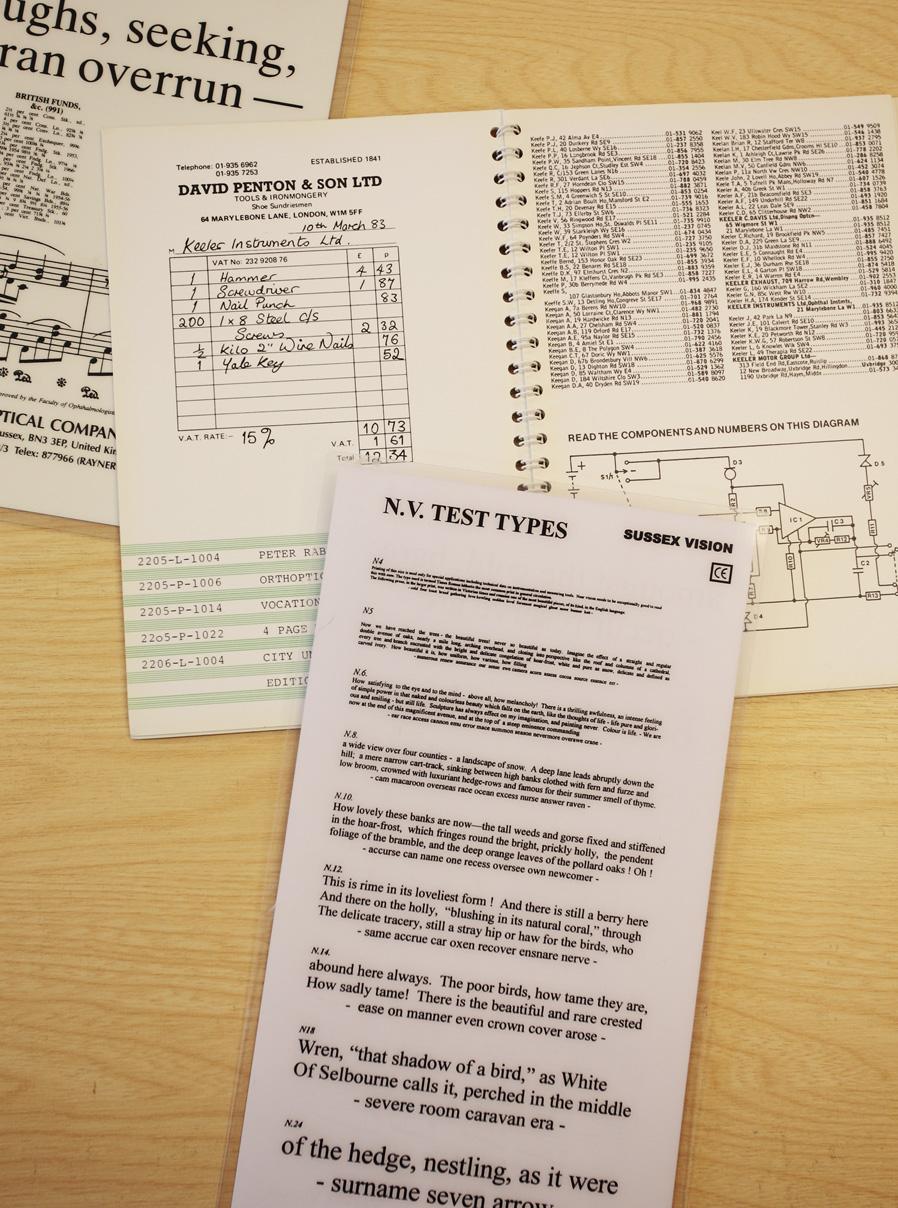
Habitual and optimal reading VA are routine measurements in presbyopes and in all patients who complain of near vision problems. Measuring unaided reading VA is optional, and should be measured in patients who are presbyopic and who do not wear spectacles for all or certain near viewing tasks (this information must therefore be obtained in the case history) or if it is required for a report.
Many types of charts are used to measure reading VA, including Jaeger, Faculty of Ophthalmologists (N-point), equivalent Snellen, Sloan reading cards (M-scale), Bailey-Lovie reading cards, and MNRead, Radner, and IReST charts. The latter five charts use a logMAR scale with typically well standardised sentence structure and have all the advantages of distance logMAR charts. , They should be used when:
An accurate, non-truncated measurement of reading VA is needed
Monitoring patients with visual impairment
Calculating the magnification needed for a low vision aid
Distance VA and reading VA may differ, such as with multifocal implants/contact lenses and patients with subcapsular cataract, in whom reading VA can be reduced with near pupillary constriction.
M-units are widely used in low vision clinics to allow easy calculation of magnification needs for low vision aids; they indicate the distance in metres at which the height of a lower case ‘x’ subtends 5 minutes of arc. A 1.0 M letter ‘x’ is therefore 1.45 mm high.
Equivalent Snellen charts and the Faculty of Ophthalmologists N-notation charts are widely used in many parts of the world. The latter chart uses the Times New Roman font and is based on the ‘point size’ used by printers and word processing packages on modern computers, in which 1 point = 1/72 inch (∼0.353 mm). This can be a useful aid when indicating to a patient the level of vision that would be provided for computer use by new lenses. N8 is approximately equal to 1.0 M and this eight times conversion holds for all print sizes. These charts are typically truncated as the smallest print sizes often provided are N5 (at 40 cm equivalent to ∼6/9 distance VA) and 0.4 M (at 40 cm equivalent to ∼20/20 distance VA) so that many patients could read sentences of text smaller than this if given the chance and a threshold is not measured. ‘Near vision adequacy’ is a more appropriate description of these measurements than reading VA. Near vision adequacy measurements have the advantage that the measurement is quicker than a threshold measurement and most patients are able to see the ‘smallest line’ of text. It is left to distance VA measurements, with its many advantages in this regard (e.g., fixed measurement distance, same letter format, letters of similar legibility), to provide an accurate measurement of a patient’s resolution. They appear to provide adequate assessment of near vision adequacy for patients with healthy eyes and good distance VA. Cards using Jaeger notation should not be used because there is no standardisation of what J1 or J5, and so on means and different charts can give different sizes of print with the same J-value. ,
(See online ![]() .)
.)
The procedure is similar to the measurement of distance VA, except that:
Measurements should be made in similar lighting conditions to those the patient uses at home. Ask if the patient uses an anglepoise or goose-neck light at home, and if they do, use additional light during your reading VA measurements.
Instruct the patient to place the reading card (or e-tablet, e-phone, or e-book reader) at their normal near working distance. Measure and record this distance.
Measure the reading VA of the poorer eye first, if a poorer eye is known from previous records or from the case history (as memorisation of the words on the chart you use may be a problem). Otherwise, measure the right eye first.
Explain to the patient what measurement you are about to take. This may be a simple: “Now we shall find out what you can see at close distances. Please read the smallest paragraph you can see.”
If a patient does not use additional lighting to read in their home and you subsequently find they cannot easily read N5 (or 0.4 M or 20/20) at the end of the reading addition part of the refraction, they should be encouraged to obtain an anglepoise or goose-neck or similar light for near tasks. It is very useful to demonstrate how helpful such additional light can be. The main objective of people with visual impairment is to be able to read and a majority can be successfully helped in primary eye care using high reading additions, simple magnifiers, and additional lighting. Note that, although reading VA levels can be associated with a range of near tasks ( Table 3.4 ), the poorer reading VAs are threshold measurements (measurements of N5, 0.4 M, and 20/20 may be truncated and not thresholds as discussed earlier) so that patients would not be able to read print of that size comfortably for any length of time. For example, to allow somebody to read newspaper print comfortably requires a reading VA better than N8 or 1.0 M, which is the typical size of newspaper print (see Table 3.4 ) as a ‘reading reserve’ of approximately 2:1 and thus a reading VA of N4 or 0.5 M is required.
| logMAR | N-scale | M-units | Equivalent Snellen (imperial) | Equivalent Snellen (metric) | Common usage |
| −0.10 | 2.5 | 0.32 | 20/16 | 6/5 | |
| 0.00 | 3 | 0.40 | 20/20 | 6/6 | Medicine bottle labels |
| 0.10 | 4 | 0.50 | 20/25 | 6/7.5 | Medicine bottle labels |
| 0.20 | 5 | 0.60 | 20/30 | 6/9 | Footnotes, bibles |
| 0.30 | 6 | 0.75 | 20/40 | 6/12 | Telephone directories |
| 0.40 | 8 | 1.0 | 20/50 | 6/15 | Newspaper print |
| 0.50 | 10 | 1.2 | 20/60 | 6/18 | Magazines, books |
| 0.60 | 12 | 1.6 | 20/80 | 6/24 | Books |
| 0.70 | 16 | 2.0 | 20/100 | 6/30 | Children’s books |
| 0.80 | 20 | 2.5 | 20/125 | 6/36 | Large print books |
| 0.90 | 25 | 3.2 | 20/160 | 6/48 | Large print books |
| 1.00 | 32 | 4.0 | 20/200 | 6/60 | Subheadlines |
| 1.10 | 40 | 5.0 | 20/250 | 6/75 | Subheadlines |
Note the working distance and then record the smallest paragraph size seen by the right and left eyes and binocularly. For approximate equivalents to other notations, see Table 3.4 . Some clinicians do not note the working distance unless it differs from the ‘norm.’ However, even patients with good vision present a wide range of normal working distances (22 cm to 50 cm for reading, and further away for computer use), and a reading acuity is meaningless without a working distance. It can also be useful to record the working distance(s) used to determine reading VA with the patient’s own spectacles to allow a comparison with the one used to determine the reading add. This can also be useful for comparison if patients return to your practice dissatisfied with the near vision in any new glasses. These cases are often due to problems with working distance determination rather than an incorrect refraction.
Reading VAs are recorded in the same format as distance VA, but should also include the near working distance in centimetres or inches. If the patient can only read a paragraph slowly or with difficulty, include this information:
| NVA c Rx. | RE: 78 | LE: 83 (VAR) @ 40 cm | |
| Near vision. | RE: N14 | LE: N12 (slowly) @ 40 cm | |
| NVAcc. | OD: 0.4 M | OS: 0.4 M | OU: 0.4M @ 38 cm |
| NVcc. | OD: 20/20 (diff.) | OS: 20/20 | OU: 20/15 @ 16” |
When determining a reading addition, do not assume you have the correct add just because a patient can see the smallest text on your near chart, such as N5, 0.4 M, or 20/20, because these charts are truncated. Apart from this truncation effect, reading VA can be expected to be similar to distance VA in most cases provided that the eye is accommodating normally or that the reading addition is correct. Notable exceptions include patients with multifocal intraocular lenses or contact lenses or patients with posterior subcapsular cataract. Patients with some eye disorders, such as amblyopia, age-related macular degeneration, and macular oedema, can have significantly worse reading VA than distance VA and isolated-letter near VA.
Not measuring or recording the test distance.
Measuring reading VA with an additional light rather than the light levels typically used by the patient in their home or at work.
A discussion with a patient with reading VA loss should include the diagnosis, management plan, and prognosis (see section 2.4 ) in lay terms. It may also include some of the information provided below that seems pertinent to your patient, ideally with a link to a suitable website and/or an information leaflet (see section 2.4 ).
The major activity limitation reported by patients with visual impairment is typically reading and improved lighting, which can significantly improve reading ability in the home, should be recommended. Furniture should be rearranged relative to windows so that daylight can illuminate newspapers and books over the patient’s shoulder. In addition, anglepoise (goose-neck) lamps with the brightest bulbs recommended for the lamp should be used in favourite reading areas. Book reading can often be improved using e-book readers, such as the Kindle, because text can be increased in size to one suitable for your patient and e-books often have the capability to switch the contrast polarity (to white letters on a black background) which reduces the extent of light scatter in the eye and improves reading further for patients with slight cataract (which is often found in patients with age-related macular degeneration as the primary diagnosis). Voice-activated books and apps or audiobooks can also be very helpful and are becoming more widely available. Electronic and optical low vision aids are available for letter writing and reading bills and letters and simple magnifiers can be useful for spot reading, such as for price tags, when shopping.
Contrast sensitivity (CS) measurements do not provide diagnostic information, but provide a much better assessment of a patient’s functional vision than VA and are standard measurements in most clinical trials of ophthalmic interventions and drugs. Assessing vision using just VA measurements is analogous to assessing hearing using just the highest pitched note a patient can hear. CS measurement is analogous to providing information about hearing lower tones and the bass, without which sounds would appear ‘thin’ and ‘tinny.’ Without CS at lower frequencies, vision can similarly appear ‘washed out.’ To assess vision fully needs more than just VA.
Poor CS has been shown to be a better predictor than poor VA of decrements in many activities of daily living, such as driving, reading, control of balance, likelihood of falling, and perceived visual disability. The CS function of patients with visual impairment can be assessed using just two measurements: standard distance VA ( section 3.1 ) plus a measure of CS close to the peak of the CS function, such as provided by the Pelli-Robson, MARS, or Melbourne edge-test ( Fig. 3.6 ) Fig. 3.6 A shows a patient with reduced peak CS and normal VA who will complain of poor vision. The CS loss could be caused by multiple sclerosis, visual pathway lesion, refractive surgery, and diabetes. , Patients with peak CS loss and VA loss (see Fig. 3.6 C), which could be caused by any eye disease, will complain of much worse visual problems than a patient with normal peak CS with the same VA (see Fig. 3.6 B). CS should therefore be measured in any patient with normal or near normal VA who complains of poor vision. This could be a patient with cataract whose symptoms suggest the need for surgery but whose VA may not and patients who have been told they have normal vision (because of normal VA) when they know they do not (see Fig. 3.6 A). Reduced CS can also explain a poor response to an optical aid by a patient with low vision and suggest the need for a contrast enhancing closed-circuit television (CCTV). Binocular CS that is better than best monocular, can also suggest the desirability of a binocular low vision aid over a monocular one.
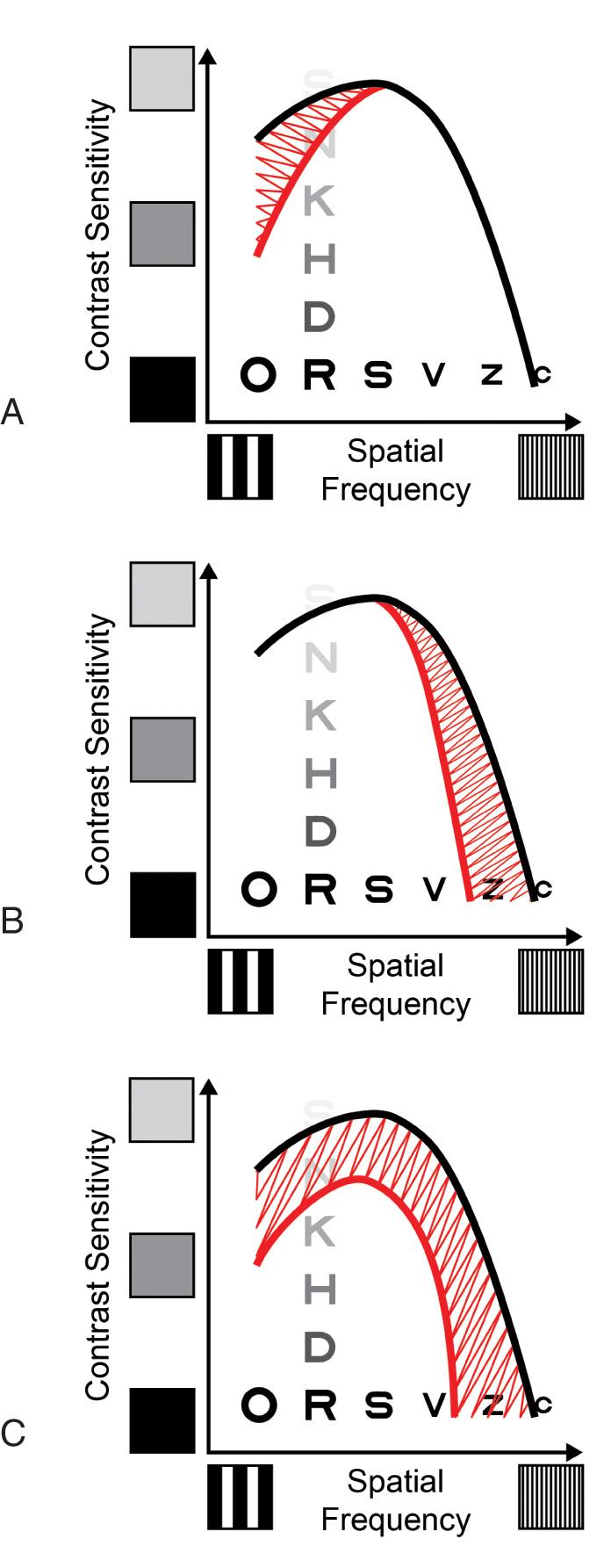
Pelli-Robson CS, which is quickly and simply measured, provides a reliable measurement of low spatial frequency CS (0.5 to 1.0 cycles/degree) when measured at the standard 1 m. It provides significantly more repeatable measures than sine-wave grating charts such as the Vistech , FACT , or CSV-1000 charts. Other large letter CS charts, such as the MARS test, are similarly repeatable, but those provided on electronic test charts may not be because of issues with liquid crystal display screens at low contrast. The Pelli-Robson chart is ideal when determining functional vision loss in patients with low vision and moderate and dense cataract; when screening for low spatial frequency loss in patients with optic neuritis, multiple sclerosis, or visual pathway lesions; when examining diabetics with little or no background retinopathy; and in patients with Parkinson’s or Alzheimer’s disease. The Pelli-Robson chart can be used at longer working distances such as 3 m, so that higher spatial frequencies are assessed and it becomes more sensitive to conditions such as early cataract. One disadvantage of the chart is that a variable endpoint can be gained depending on how long the patient is left to stare at the letters near threshold.
Illuminate the chart ( Fig. 3.7 ) to between 60 and 120 cd/m 2 . If room lighting is inadequate, ensure the additional lighting provides a uniform luminance over the chart and avoids specular reflections from the surface.
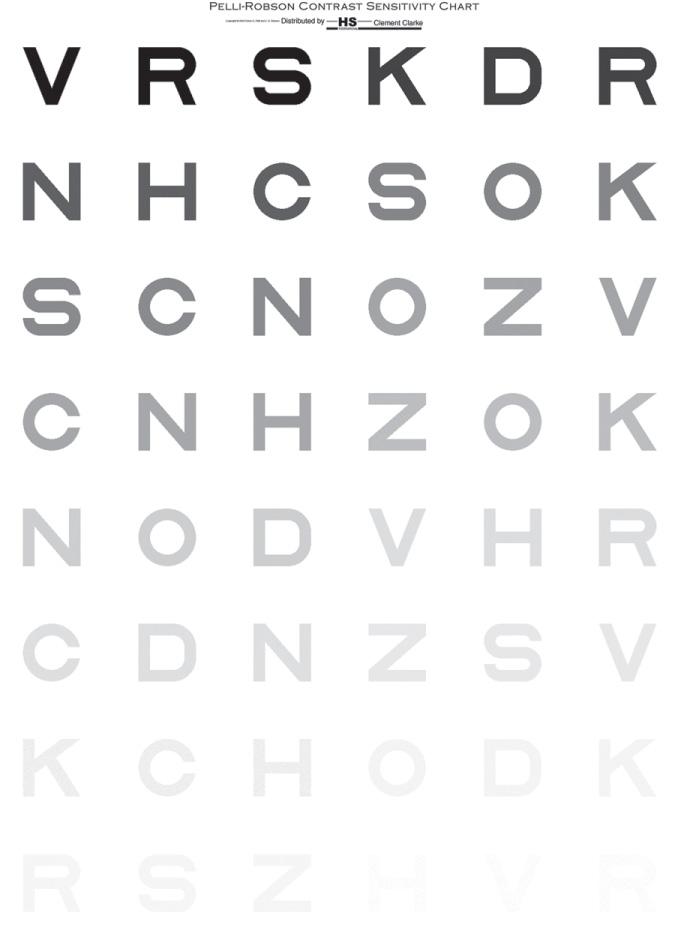
Sit/stand the patient 1 m from the chart, with the middle of the chart at eye level. Longer distances can be used if required.
Patients can wear their own distance spectacles because measurements are relatively immune to moderate dioptric blur.
Occlude one eye.
Ask the patient to read the lowest letters that they can see, and encourage the patient to guess. Once the patient states that they cannot see any further, indicate where the next lower contrast triplet is on the chart and ask the patient to keep looking at this point for at least 20 seconds. Generally, if given sufficient time, at least one more triplet of letters will become visible in this manner.
Count the reading of the letter C as an O as a correct response to further balance the legibility of the letters.
Score 0.05 log CS for every letter read correctly (the first triplet should be ignored as it has a log CS value of 0.00). This ‘by-letter’ scoring provides a more repeatable and sensitive measurement than the manufacturer’s recommended scoring of the lowest line at which the patient can read two of the three letters.
Repeat the measurements in the other eye and binocularly as required.
Record the CS score in log units.
Examples:
Pelli-Robson. RE: 1.70 log CS, LE: 1.75 log CS, BE: 1.85 log CS
Pelli-Robson. OD: 1.70 log CS, OS: 1.25 log CS, OU: 1.65 log CS
For patients between 20 and 50 years of age, monocular CS should be 1.80 log units and above; for patients less than 20 years of age and older than 50 years, monocular CS should be 1.65 log units and above. It is best to obtain your own norm values. If the monocular scores are equal, the binocular score should be 0.15 log units higher (binocular summation). With increasingly unequal monocular CS, the binocular summation will reduce and, in some patients, the best monocular score can be better than the binocular (binocular inhibition).
Not allowing the patient at least 20 seconds for the letters to become visible when the patient is near threshold.
Not pushing the patient to guess.
Inappropriate use of the occluder so that the patient can see the chart binocularly when monocular measurements are being made.
Not using by-letter scoring.
Small-letter CS is more sensitive than traditional VA to several clinical conditions, such as early cataract and contact lens oedema, and should be ideal when attempting to measure subtle losses of vision such as after refractive surgery. CS of very small letters, such as 20/30, correlates very highly with VA and the ideal size for a small-letter test may be about 20/50. The measurement procedure is very similar to that for the Pelli-Robson chart.
Low-contrast VA charts measure the smallest letter that can be resolved at a fixed contrast and do not measure CS. It is difficult to state which spatial frequencies the low-contrast letter charts are measuring, because this depends on the VA threshold. If only the large letters at the top of the chart can be seen, the score gives an indication of CS at intermediate spatial frequencies. If a patient can see the small letters at the bottom of the chart, the score gives an indication of higher spatial frequencies. Low-contrast VA scores are believed to indicate the slope of the high-frequency end of the contrast sensitivity function (CSF). It has been suggested that they can be used to indicate the CSF when used in combination with a low-frequency or peak CS measure such as the Pelli-Robson chart and a high-contrast VA measurement. The lower the contrast of the acuity charts, the more sensitive they are to subtle vision loss. For example, for detecting subtle vision losses in aviators or subtle changes after refractive surgery, 5% to 10% charts should be used. For greater losses in vision, such as cataract, even the large letters on these very low-contrast charts cannot be seen by some patients, and a higher-contrast chart at about 25% is necessary. As with high-contrast VA measurements, charts that follow the Bailey-Lovie (logMAR) design principles should be used and the measurement procedure is the same as for high contrast VA ( section 3.1.2 ).
A discussion with a patient with visual impairment should include the diagnosis, management plan, and prognosis ( section 2.4 ) in lay terms. It may also include some of the information provided below that seems pertinent to your patient, ideally with a link to a suitable website and/or an information leaflet (see section 2.4 ).
Patients with good VA: Patients complaining of poor vision who have been told by other clinicians that their vision is fine because their VA is fine are relieved when a clinician agrees with them that their vision is poor and is caused by reduced CS. Explain that their vision will be particularly poor in low-contrast conditions such as dim lighting, fog, and rain or looking through grubby windscreens or glasses.
Mobility and falls: Difficulties with balance control, walking, avoiding obstacles, and negotiating steps and stairs have all been linked with reduced CS more than reduced VA. They are particularly important because they can lead to falls, which is a very common and disabling problem for older people ( section 4.15.4 ). Patients with visual impairment should be referred to the appropriate health professionals who deal with home modification strategies that can help prevent falls, such as improved lighting throughout the home, but particularly on stairs, handrails on both sides of stairs, step edge highlighters, and the removal of clutter and loose rugs.
Watching TV: Position the TV to make sure that the contrast is not reduced by glare from windows and bright lights. Magnification can be provided by sitting closer to the TV, and if possible, buying a larger TV.
Improving contrast in the home: Patients with CS impairment can greatly benefit from home modifications that increase contrast. Have a selection of plain white and dark plates, which will make the stack of plates easier to see ( Fig. 3.8 ) and can be used for pale food such as fish pie (dark plates) and darker food such as stew (white plates); the same idea can be used for chopping boards, bowls, cups, and so on. Light switches should have a white surround with a dark switch or viceversa; and similarly with doors and door handles/knobs ( Fig. 3.8 ), stair rails with walls, and finally steps should have high-contrast edge highlighters.
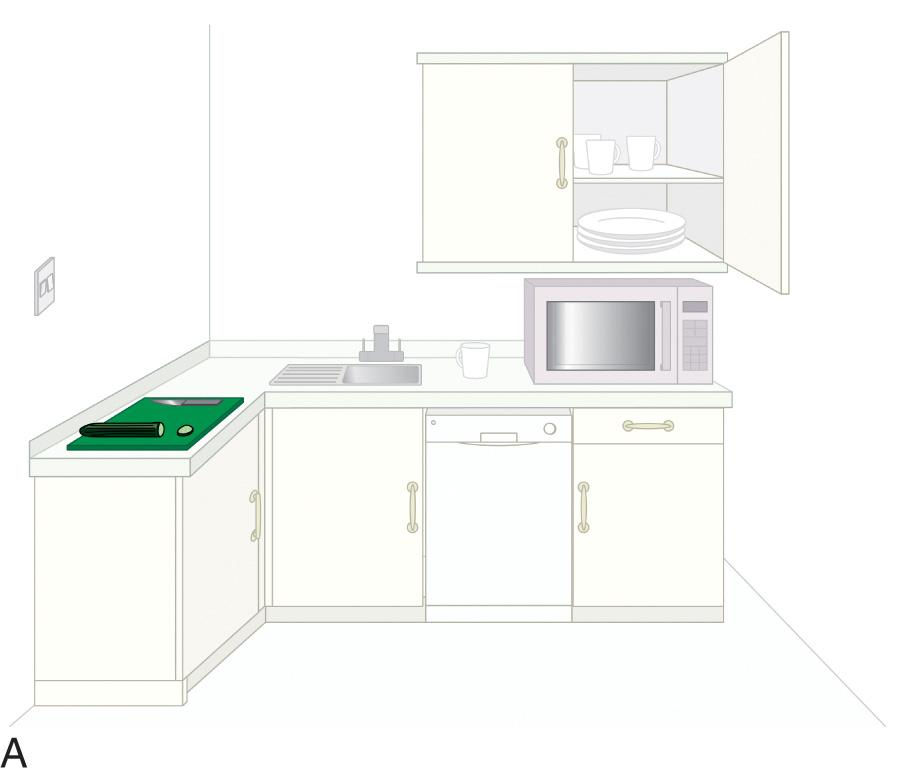
Congenital colour deficiency is found in both eyes equally and does not change over time. It is virtually always a red–green deficiency and is far more common in males than females as it is an X-linked disorder ( Table 3.5 ). Approximately 8% (1 in 12) of the male and 0.5% (1 in 200) of the female population are red–green deficient, with the great majority of females being anomalous trichromats. Dichromats, with only two of the three cone photopigments, have the most severe type of colour vision anomaly. Deuteranopes (∼1% of males) lack the ‘green-catching’ chlorolabe and protanopes (∼1% of males) lack the ‘red-catching’ erythrolabe. Anomalous trichromats have all three photopigments, but either the red (protanomalous trichromats, 1% of males) or green photopigments (deuteranomalous trichromats, 5% of males) provide less discriminative colour vision than normal. Their level of colour vision anomaly ranges from near normal to near dichromat levels .
| Father normal colour vision XY | Father colour defective x Y | |
| Mother normal colour vision (XX) | XX or XY All children will have normal colour vision |
X x or XY All sons have normal colour vision. All daughters will be carriers |
| Mother carrier (X x ) | XX or X x ; XY or x Y 50% chance of daughters being carriers, 50% chance of sons having colour deficiency |
x x or X x ; XY or x Y 50% chance of daughters being carriers or colour defective, 50% chance of sons having colour deficiency |
| Mother colour defective ( x x ) | x X; x Y All sons will be colour defective, all daughters will be carriers |
x x ; x Y All children are colour defective |
Because of the increased use of colour as a teaching aid in schools, it is important to test the colour vision of all children before or soon after they start school. Patients with normal colour vision can make errors on the Ishihara tests, but they do not provide the specific red–green errors so that false–positive findings are not really an issue ( section 1.3 ). However, given the much lower prevalence of congenital colour vision in females, some clinicians may prefer just screening females with a family history of the condition (see Table 3.5 ).
The Ishihara test ( Fig. 3.9 ) is a very efficient screening test for red–green colour deficiency and provides quick and simple measurements. It is by far the most commonly used colour vision test and is a required entrance test for several professions throughout the world, including the armed forces, and aviation and railway industries. Disadvantages include that the Ishihara plates were designed as a screening test around the normal/abnormal boundary and are less useful for grading the severity of colour deficiency or for monitoring an acquired colour deficiency and they do not assess tritan (blue–yellow) colour problems. For these tasks, either the City University or Farnsworth D-15 tests or similar tests are recommended. After several years, note that the colours on the Ishihara plates can fade and the test loses its validity. Tests similar to the Ishihara are available on smartphone apps, and they provide a modern, widely available, and more affordable test with fewer issues regarding colours fading. However, there is currently a lack of uniformity with screen colours and size and some app tests have poor specificity and falsely identify colour normals as colour defective. , It seems likely that a Ishihara-type test will be validated for use on a tablet or similar device in future years.
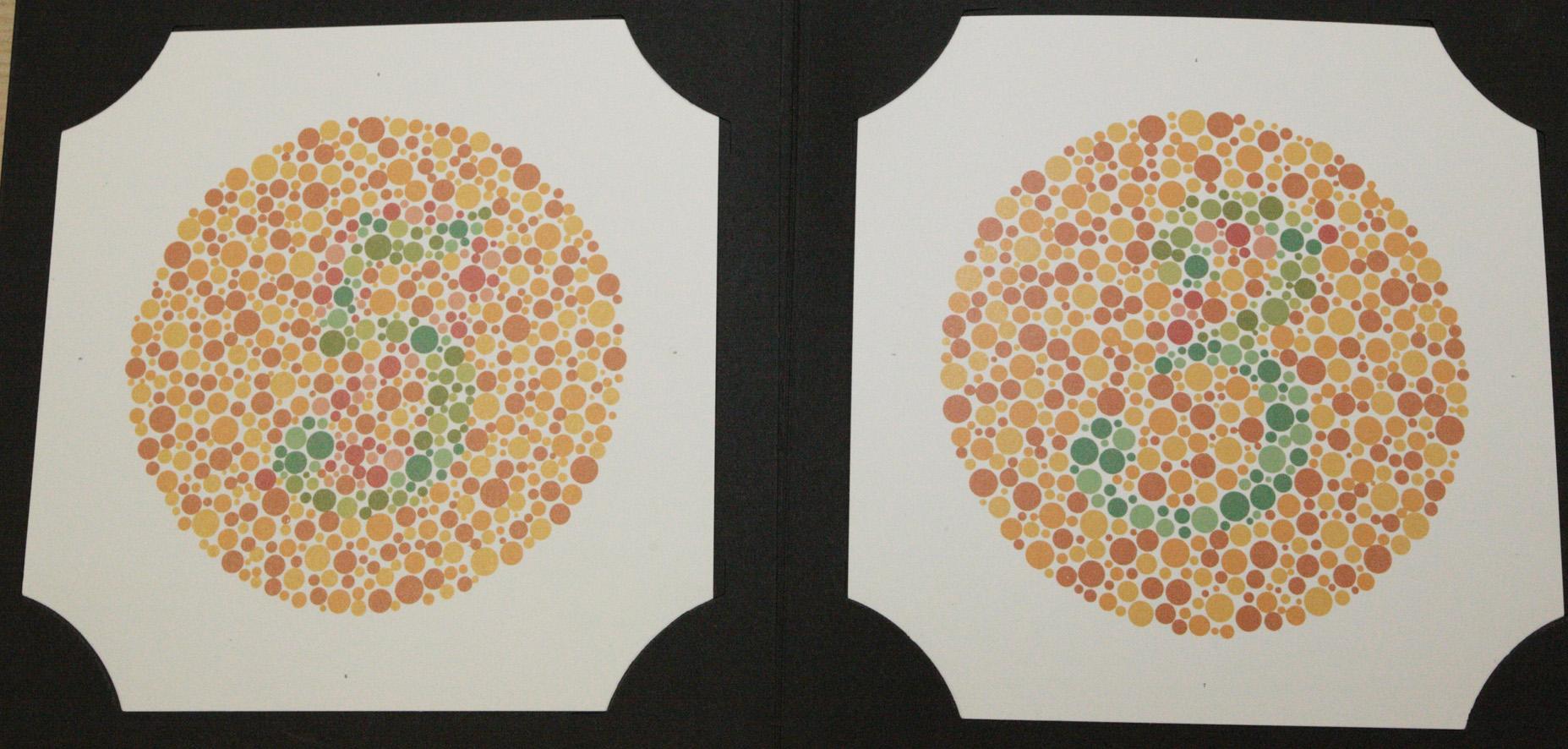
(See online ![]() .)
.)
The Ishihara test is made up of several plates that present various numbers made up of coloured dots of varying size embedded in a background of different coloured dots (see Fig. 3.9 ). The colours of the number and background dots are chosen so that they are confused by patients with red–green colour defects (i.e., they appear isochromatic to those with colour defects), but discriminated by patients with normal colour vision. Plate 1 is a demonstration plate that should be read by all literate patients and can be used to indicate malingerers. Different designs of pseudoisochromatic plates follow, and include transformation (plates 2–9), vanishing (10–17), and hidden digit (18–21) plates. Normal trichromats can see numbers on all but the hidden digit plates. Patients with red–green colour deficiency do not see a number on the vanishing plates, see a different number than normals on the transformation plates (see Fig. 3.9 ), and can see a number on the hidden digit plates. Classification plates, which attempt to differentiate protans and deutans, are found on plates 22 to 25. Two numbers are shown on each plate. The right-hand number (blue–purple) is not seen or seen less well by deutans, and the left-hand number (red–purple) is not seen or less well seen by protans ( Fig. 3.10 ). The rest of the plates contain pseudoisochromatic pathways and are used for patients who cannot read letters, such as young children. The patient’s task is to trace the pathway ( Fig. 3.11 ).
You must use the proper quantity and quality of illumination, because the colour temperature of the illuminant will affect the colours of the test. Colour vision testing is normally performed under a standard source, such as one of the Gretag Macbeth Sol-Source daylight desk lamps. This simulates natural daylight conditions provided by direct sunlight and a clear sky. Because these desk lamps are expensive, alternative sources are also used. For example, you can use high colour rendering fluorescent lights (>5000 K) or a Kodak Wratten #78AA filter (found in camera shops) placed in front of the patient’s eye in conjunction with a 100-watt incandescent light source. Natural daylight is not recommended due to its variability in both the quality and quantity of light, although even this is preferable to tungsten lighting.
The Ishihara test (unlike other pseudoisochromatic tests) is insensitive to changes in working distance, duration, and blur, so that deviations from the manufacturer’s recommended viewing distance (75 cm) and viewing time (≤ 3 seconds) do not make a significant difference to errors.
Explain to the patient that you are going to test their colour vision.
If screening for a congenital defect, measure colour vision binocularly. If screening for an acquired defect, measure colour vision monocularly.
Ask the patient to use their near vision correction and hold the booklet at approximately 75 cm. Tinted glasses or contact lenses should be avoided.
Ask the patient to read the numbers, starting at plate 1. The patient should be allowed only about 3 seconds to view each plate.
Use the results sheet to keep a count of any errors. Allow patients another attempt if they make mistakes that are NOT the specific mistakes that those who are red–green colour defectives make.
If a patient makes three or more errors, use the classification plates and attempt to categorise the colour defect. Categorise the patient as deutan if the blue–purple letter is not seen or is less visible or protan if the red–purple letter is not seen or is less visible.
Any patient who is diagnosed as colour defective should be counselled regarding the effects of the colour vision deficiency on their everyday life and on future career restrictions.
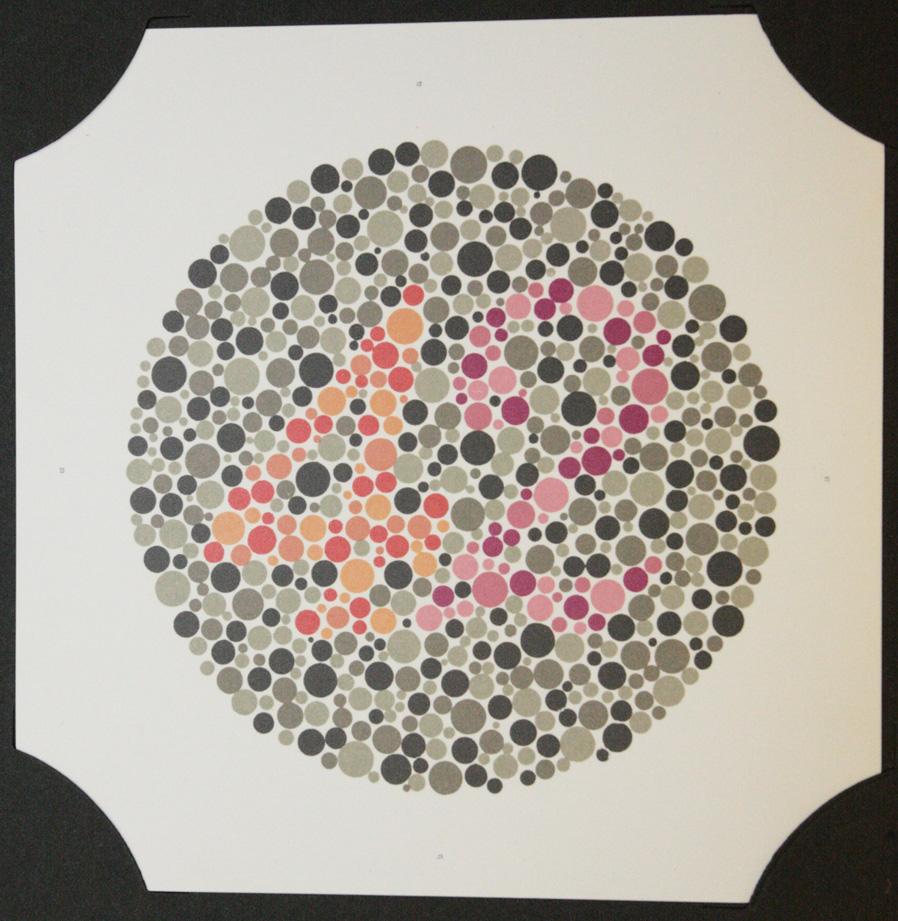
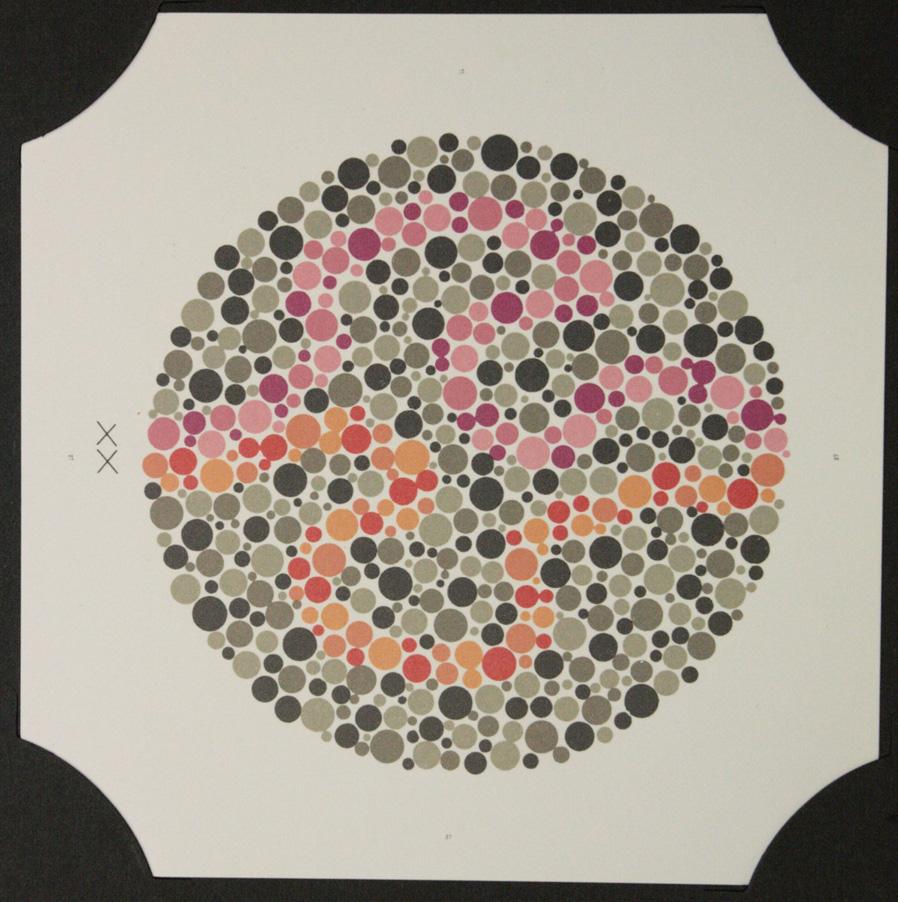
Record the number of plates correctly determined from the number of plates attempted. If a patient fails the test, attempt to categorise the defect using the result from the classification plates and record any advice given to the patient and their family.
Examples:
Ishihara 15/16 correct. Normal colour vision
Ishihara 8/16 correct. ? Deutan. Patient advised re. effects and future career restrictions
Ishihara 2/16 correct. Protan. Patient given leaflet re. colour deficiency
Patients with red–green colour defects will make specific errors as indicated in Table 3.6 . Generally, three or more errors constitute a fail, although entrance requirements for some professions allow no errors. , Some clinicians do not present the hidden-digit plates, which are not very sensitive to colour deficiency, and just present transformation and vanishing plates. Mistakes that are NOT the specific mistakes that people who are red–green colour defective make should be viewed with caution, as they are much less likely to indicate red–green colour deficiency.
| Plate | Normal | Person with red–green deficiency | Person with total colour blindness | ||
|---|---|---|---|---|---|
| 1 | 12 | 12 | 12 | ||
| 2 | 8 | 3 | X | ||
| 3 | 29 | 70 | X | ||
| 4 | 5 | 2 | X | ||
| 5 | 3 | 5 | X | ||
| 6 | 15 | 17 | X | ||
| 7 | 74 | 21 | X | ||
| 8 | 6 | X | X | ||
| 9 | 45 | X | X | ||
| 10 | 5 | X | X | ||
| 11 | 7 | X | X | ||
| 12 | 16 | X | X | ||
| 13 | 73 | X | X | ||
| 14 | X | 5 | X | ||
| 15 | X | 45 | X | ||
| PROTAN | DEUTAN | ||||
| Strong | Mild | Strong | Mild | ||
| 16 | 26 | 6 | (2)6 | 2 | 2(6) |
| 17 | 42 | 2 | (4)2 | 4 | 4(2) |
Using an inappropriate light source.
Attempting to assess an acquired colour deficiency using only the Ishihara test.
Become a Clinical Tree membership for Full access and enjoy Unlimited articles
If you are a member. Log in here